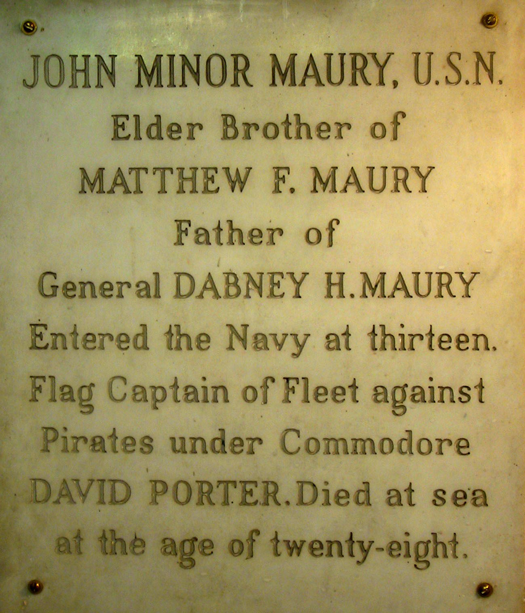
This was part one of a series of articles exploring the individuals who are the subjects of the various plaques located in the Church. Many of these have been recently hung after having been stored during the renovation (2008-2011). Do you notice the plaques? Did you ever want to know more about the lives commemorated by them?
This month’s plaque is hung in the stairway in the narthex going down to Sydnor Hall. When going down to Sydnor Hall, imagine yourself going down to a ship’s galley and you will have an appropriate setting for this month’s story.
Most of the individuals commemorated on the plaques are not household names, including this month’s subject John Minor Maury. Maury was eclipsed by his famous younger brother Matthew Fontaine Maury, the “pathfinder of the seas” and professor and his son General Dabney Maury. Dabney Maury who commanded a division during the Civil War went on to write his memoirs about that war and others. He also was a minister to Colombia and founded the Southern Historical Society.
Maury had a later relative at St. George’s. He was a first cousin (once removed) from Rev. Magruder Maury who served as rector from 1864-1871. Rev. Magruder’s grandfather, Fontaine Maury, was the brother of Richard Maury father of John Magruder Maury and Matthew Fontaine Maury.
The Maury family left Fredericksburg in 1811 to move to Franklin, Ten. or when JM was 16 . By that time JM had been sailing since 1808 and had already been appointed a midshipman in the navy in 1809 and commissioned in 1811. JM was inspiring to younger brother Matthew. Maury’s letters of his adventures in the navy that were sent home were considered to be a major reason why Matthew Maury decided on a naval career much to the chagrin of his father. “JM” married a first cousin Eliza Herndon Maury, daughter of Elizabeth Brooke and Fontaine Maury.
One of the adventures that inspired his brother was his sailing to China under a Captain William Lewis as a first officer. This was a trading voyage but while there they had obtained furloughs. Maury, with six men, was left on the island of Nokaheeva to collect sandal-wood and other valuable articles of trade against the return of the ship. The War of 1812 broke out, and Captain Lewis was blockaded in a Chinese port. To make matters worse, Maury and his men were beset by the natives of one part of the island who were fighting a civil war against another group. All of the party except Maury and another sailor were killed. These two constructed a place of refuge in the tops of four cocoanut trees which grew close enough together and provided a safe haven from the natives. The Essex under David Porter later saved them possibly due to the recognition of Maury by one of the shipmates. Porter had captured another ship which he renamed Essex Jr and Maury became its first lieutenant.
Maury later served on the War of 1812 under Command Thomas McDonough in the victory of the Battle Lake Champlain which decimated the British fleet there. He wrote to a friend in Fredericksburg, “We have gained a glorious victory. I hope the most important result of it will be to confirm the wavering allegiance of New York and Vermont to the Union. They have been threatening to secede unless peace be made with England on any terms!”
One of the unique episodes in the early American republic was the dealings with pirates, those closer to Africa, the Barbary pirates and those nearer in the West Indies. Captain David Porter was ordered to fit out a squadron for their destruction. He was authorized to select his officers for this dangerous mission. His first choice was Lieutenant John M. Minor to be flag captain of the fleet. This officer, like the adjutant general of the army, gave orders for all the movements. The service was active and severe; the combats were desperate; no quarter was asked or given. The pirates were all destroyed or broken up and scattered.
As a demonstration of Maury’s services, he was sent by Porter to report to the US government of the success of the mission. However, he died of yellow fever just outside Norfolk and buried at sea. Throughout his short career, Maury had gained the respect of his peers. His brother wrote that at “the time of his death he was the highest ranking officer of his age in the service.”
Dabney Herndon, the cashier of the Farmer’s Bank (just across from St. George’s) took Maury’s widow and her two sons to his home, where they lived until his death. Maury’s oldest son had already died in childhood and is buried at the Masonic Cemetery. JM’s famous brother Matthew Fontaine Maury later married Herndon’s eldest daughter, Ann. One of Dabney Herndon’s cousins was Ellen Herndon who later married future president Chester Arthur.
